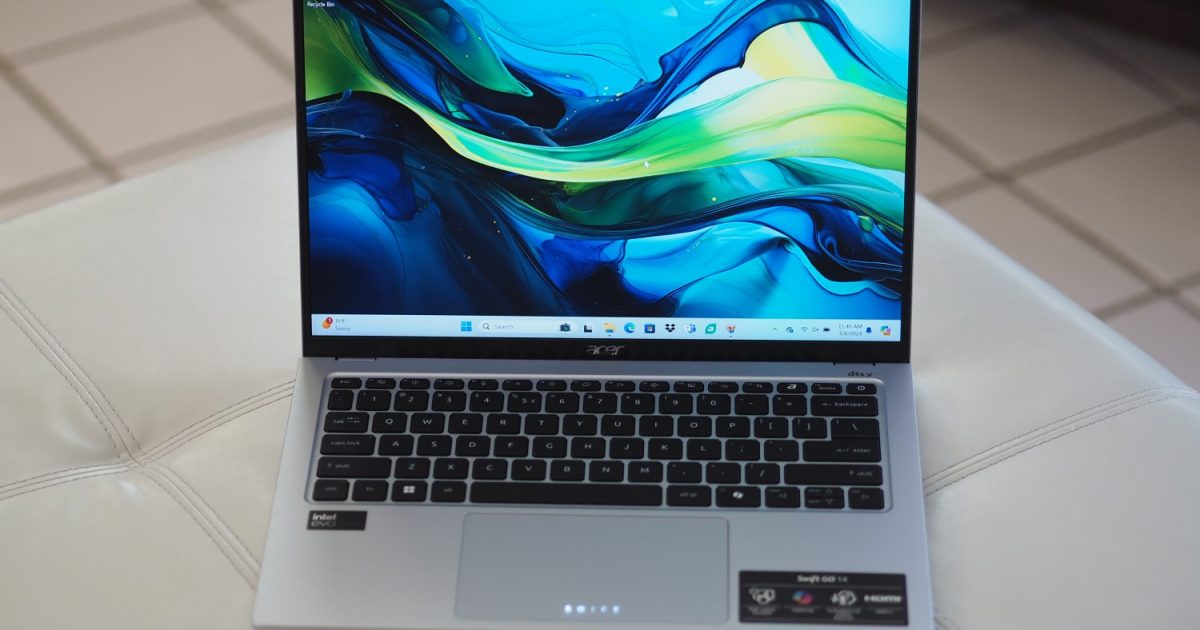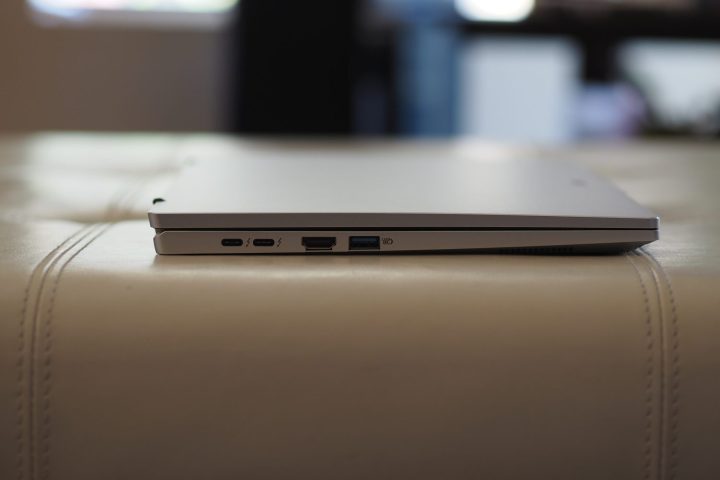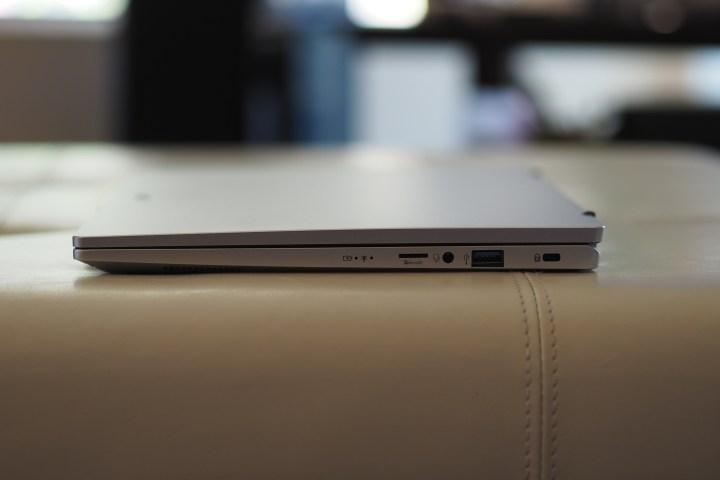
Acer Swift Go 14 2024
MSRP $800.00
“The Acer Swift Go 14 is too vanilla to compete.”
Pros
- Fast productivity performance
- Very good keyboard
- Good IPS display
- Reasonably thin and light
Cons
- Chassis is wobbly
- Touchpad is subpar
I’ve reviewed some impressive 14-inch laptops lately. Some have been expensive, while others have been reasonably affordable. So many have been awesome. But the latest Acer Swift Go 14 isn’t one of them.
I mean, it’s not a bad laptop. A couple of years ago, I would have recommended it, warts and all. It’s reasonably fast, has decent battery life, and sports a pretty good IPS display. But that’s just not enough right now. If you want to compete, you have to offer something special — and the Swift Go 14 does not.
Specs and configurations
| Acer Swift Go 14 SFG14-73T | |
| Dimensions | 12.23 inches x 8.67 inches x 0.66-0.74 inches |
| Weight | 3.05 pounds |
| Processor | Intel Core Ultra 5 125H Intel Core Ultra 7 155H |
| Graphics | Intel Arc |
| RAM | 16GB |
| Display | 14.0-inch 16:10 WUXGA (1920 x 1200) IPS touch, 60Hz |
| Storage | 512GB SSD 1TB SSD |
| Touch | Yes |
| Ports | 2 x USB-C with Thunderbolt 4 2 x USB-A 3.2 Gen 1 1 x HDMI 2.1 1 x 3.5mm audio jack 1 x microSD card reader |
| Wireless | Wi-Fi 7 and Bluetooth 5.3 |
| Webcam | QHD (1440p) |
| Operating system | Windows 11 |
| Battery | 65 watt-hours |
| Price |
$800+ |
The Swift Go 14 comes in several models, and I’m reviewing the SFG14-73T model that’s currently available at Acer’s web store in two configurations. For $830, you get a Core Ultra 5 125H chipset, 16GB of RAM, a 512GB SSD, Intel Arc graphics, and a 14.0-inch WUXGA IPS panel. For $950, you get the same with a Core Ultra 7 155H.
A couple of years ago, those would be excellent prices for this class of machine. Today, Acer faces some stiff competition for around the same money. The Asus Zenbook 14 Q425, for example, is $800 for the same base specs but with an OLED display and a more modern design; on sale, I’ve seen that config for as low as $500 and the high-end model with identical specs at $800.
That said, if you’re a Costco member, you can get the Swift Go 14 with Core Ultra 7, 16GB of RAM, and a 1TB SSD for $800. That’s a more attractive option, given the extra storage it come with.
Design
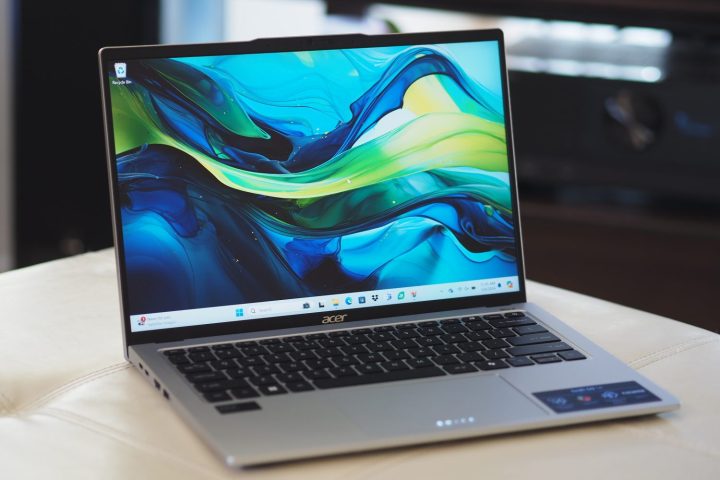
Somehow, the Swift Go 14 strikes me as sort of an old-school 14-inch laptop. It has a silver chassis with black keys and prominent vents along the rear edge. The display has reasonably narrow bezels but they’re plastic rather than being set behind a solid piece of glass. And, while the overall branding is subdued, the bright “Swift” light on the touchpad sticks out — maybe a little too much. It’s not an unattractive laptops, but the Dell XPS 14 and Asus Zenbook 14 Q425 still manage to come across as more contemporary.
The Swift Go 14 has a mixed build quality. Its all-aluminum chassis and lid resist bending, flexing, and twisting for the most part. But it didn’t exhibit the kind of dense rigidity I’ve come to expect.
For example, the chassis was the tiniest bit wobbly as I used it, with the right side sticking up just enough that I felt it hitting my desktop when I opened the lid. Other laptops, like the XPS 1, Zenbook, and Apple MacBook Air M3, feel more solid and, frankly, the Swift Go 14 just wasn’t the same. That could have just been a flaw with my review unit, but it didn’t give me the same sense of quality.
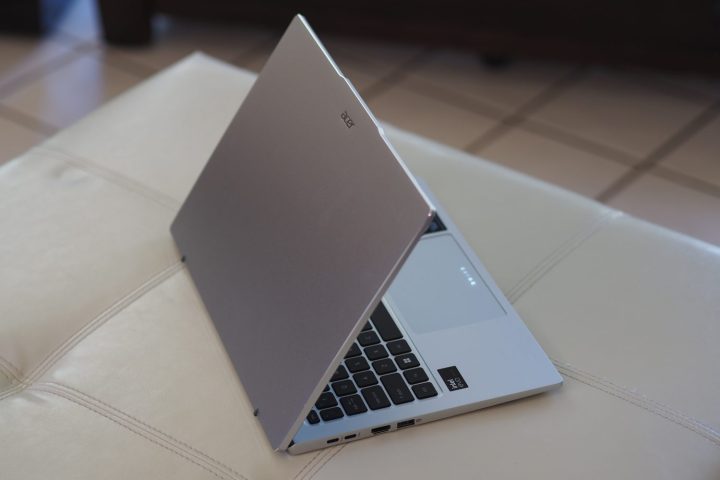
In terms of portability, the Swift Go 14 is decidedly middle of the pack. It’s reasonably thin at 0.74 inches and light at 3.05 pounds. But the Zenbook 14 is thinner at 0.59 inches and lighter at 2.82 pounds, and the XPS 14 is thinner at 0.71 inches but heavier at 3.7 pounds. And the MacBook Air is incredibly thin at 0.44 inches and light at 2.7 pounds, albeit with a slightly smaller display. Overall, the Swift Go 14 is reasonably easy to carry around.
Keyboard and touchpad
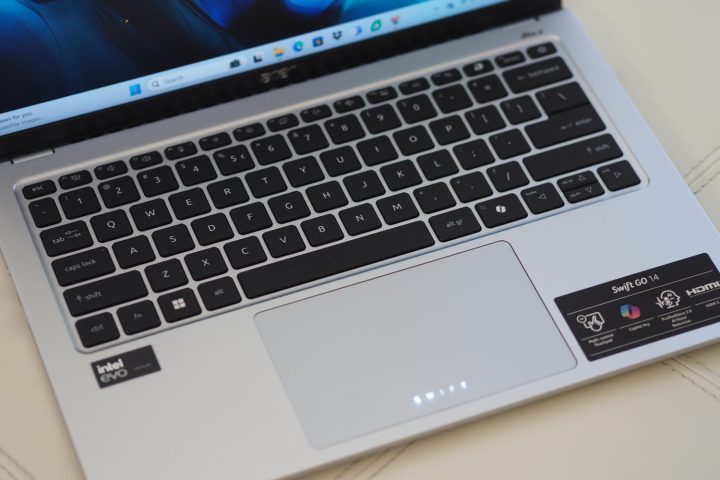
The Swift Go 14’s keyboard is very good, with smaller keycaps but plenty of key spacing. Its switches are light and snappy, with a comfortable bottoming action. I found it easier to get used to than the XPS 14’s zero-lattice keyboard and as good as the Zenbook 14’s, while a step behind the MacBook Air’s. The keyboard includes the Microsoft Copilot key, but that’s of questionable value given that it merely opens the cloud-based Copilot feature in Windows 11.
The mechanical touchpad is large enough, and while I welcome the movement toward haptic touchpads on Windows laptops, that’s still a mostly premium feature at this point. The problem here is that the Swift Go 14’s touchpad has very stiff buttons that aren’t terribly responsive. I found myself either failing to register a click or double-clicking when I didn’t mean to. It was a frustrating experience all around. The Zenbook 14’s mechanical touchpad is much better, and the XPS 14’s and MacBook Air’s haptic versions are even better yet.
The Swift Go 14 does have a touch-enabled display by default, so that’s a plus that is optional (or unavailable) on some other 14-inch laptops.
Connectivity
One positive old-school aspect of the Swift Go 14 is its more expansive connectivity. While laptops like the XPS 14 and MacBook Air have gone all-in on Thunderbolt 4, the Acer includes a good mix of modern and legacy connectivity. And the available Wi-Fi 7 and Bluetooth 5.3 is about the most up-to-date wireless connectivity available.
The webcam is also better than the contemporary standard, coming in at 1440p versus the increasingly common 1080p standard. Acer builds in several tools to enhance videoconferencing quality, such as its AI-enabled Temporal Noise Reduction. Acer also has its branded PurifiedView that works with Windows Studio effects for automatic framing, advanced background blur, and gaze correction. Studio Effects can utilize the Neural Processing Unit (NPU) in the Meteor Lake chipset, which is also supported in a few apps like Gimp. So far, though, the NPU’s benefit is limited.
Performance
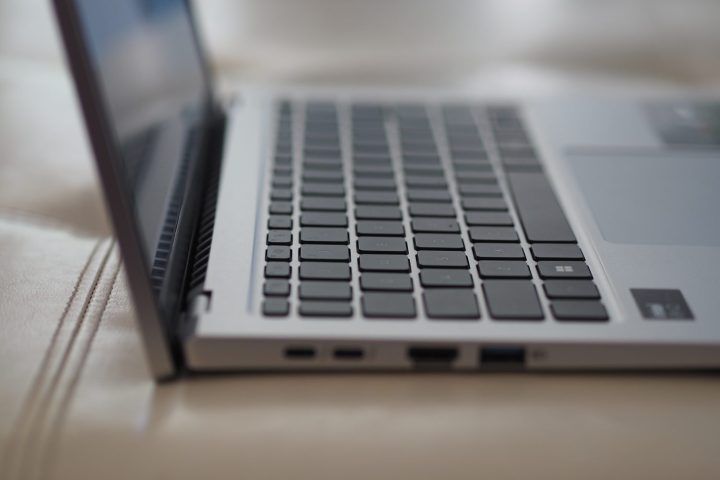
By now, I’ve reviewed enough laptops with Intel’s latest Core Ultra 7 155H to have a sense of their relative performance. The chipset runs at 28 watts and has 16 cores (six Performance, eight Efficient, and two Low Power Efficient) and 22 threads. It’s a very good performer for productivity tasks, and its integrated Intel Arc graphics are a step up from the pervious generation but still considerably slower than entry-level discrete GPUs.
In our CPU-intensive benchmarks, the Swift Go 14 was among that fastest machines we’ve tested using the Core Ultra 7. Its performance mode provided a meaningful boost, but the fans got quite loud during the most intensive benchmarks. The bottom vents mean that you have to be careful of the surface the laptop is sitting on, and the bottom of the chassis got a bit warm.
Its Intel Arc graphics were in the upper range of what we’ve seen from the chipset, and that contributed to a higher score in the Creation portion of the PCMark 10 Complete benchmark and an overall higher score.
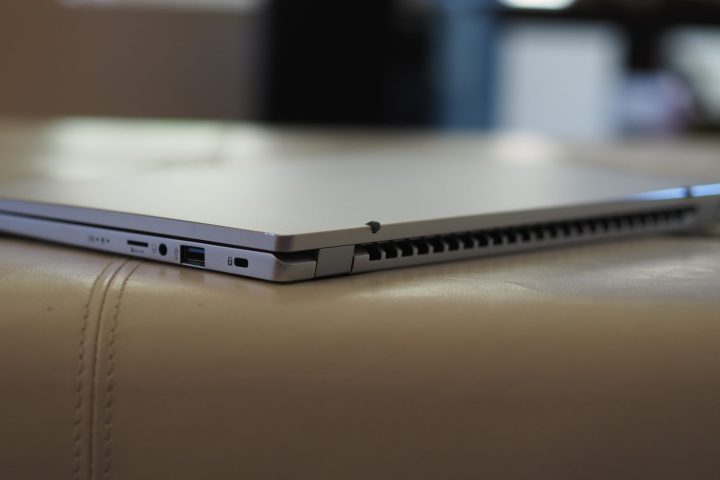
While the lack of a discrete GPU option holds the Swift Go 14 back in creative apps and games, the laptop is nevertheless an incredibly fast option for demanding productivity users.
| Geekbench 6 (single/multi) |
Handbrake (seconds) |
Cinebench R23 (single/multi) |
PCMark 10 Complete | |
| Acer Swift Go 14 (Core Ultra 7 155H) |
Bal: 2,269 / 12,007 Perf: 2,269 / 12,119 |
Bal: 72 Perf: 69 |
Bal: 1,760 / 13,315 Perf: 1,773 / 14,948 |
6,767 |
| Asus Zenbook 14 Q425 (Core Ultra 7 155H) |
Bal: 2,257 / 11,820 Perf: 2,279 / 11,806 |
Bal: 94 Perf: 82 |
Bal: 1,706 / 8,684 Perf: 1,758 / 10,899 |
6,086 |
| Lenovo Yoga 9i Gen 9 (Core Ultra 7 155H) |
Bal: 2,396 / 14,270 Perf: 2,426 / 14,406 |
Bal: 98 Perf: 81 |
Bal: 1,802 / 10,576 Perf: 1,792 / 12,558 |
6,640 |
| HP Spectre x360 14 (Core Ultra 7 155H) |
Bal: 2,185 / 11,123 Perf: 2,176 / 11,980 |
Bal: 138 Perf: 83 |
Bal: 1,750 / 9,832 Perf: N/A |
6,316 |
| Lenovo Yoga 9i Gen 8 (Core i7-1360P) | Bal: 2,509 / 10,746 Perf: 2,553 / 11,324 |
N/A | Bal: 1,846 / 8,779 Perf: 1,906 / 9,849 |
6,102 |
| Asus Zenbook 14X OLED (Core i7-13700H) | Bal: 2,501 / 11,991 Perf: 2,512 / 11,862 |
N/A | Bal: 1,819 / 11,066 Perf: 1,826 / 12,795 | 6,020 |
| Apple MacBook Air (M3) |
Bal: 3,102 / 12,078 Perf: N/A |
Bal: 109 Perf: N/A |
N/A | N/A |
Battery life
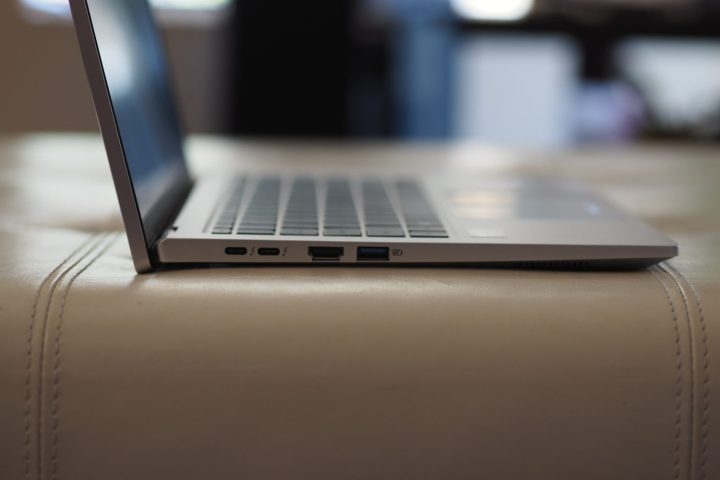
The combination of a 65-watt-hour battery and a FHD+ IPS display promise good battery life. Laptops with the Core Ultra 7 have demonstrated mixed battery life, though, so I wasn’t expecting miracles.
In our web browsing test, the Swift Go 14 managed around 11 hours, which is a relatively strong showing for a 14-inch laptop. The XPS 14 with its IPS display hit around 12 hours, while the Zenbook 14 Q425 was around 12.5 hours with an FHD+ OLED display. However, those are stronger scores than some others that were closer to eight hours. The Swift Go 14 lasted for 12.5 hours in our test that loops a local video, compared to the XPS 14’s 15 hours and the Zenbook’s incredibly strong 18 hours. The MacBook Air has the best battery life of them all. But again, most laptops we’ve tested have been closer to the Acer’s score.
Overall, the Swift Go 14 had good but not great battery life. It might make it through much of a day with a light workload, but there are no guarantees.
Display and audio
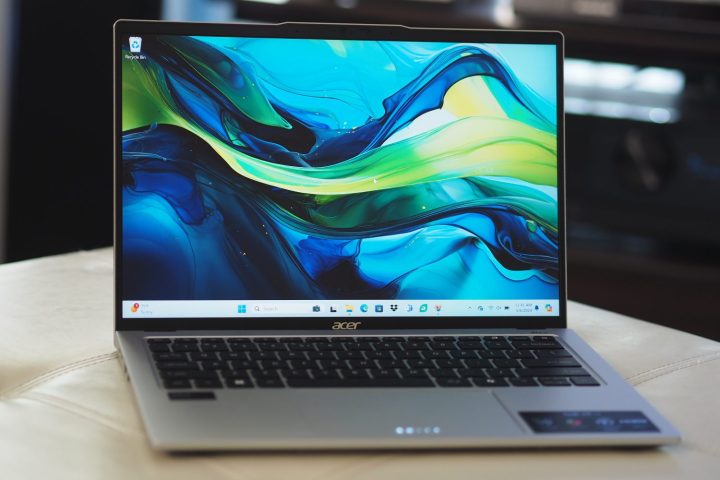
The Swift Go 14 has one display option: a 14.0-inch 16:10 IPS panel running at FHD+ (1920 by 1200) resolution and 60Hz. That’s a fine choice for battery life, but several other 14-inch laptop manufacturers include OLED options and many at higher resolutions.
Acer’s choice in panels was OK by IPS standards, according to my colorimeter. First, it was a bright panel at 448 nits, following a trend toward much higher brightness. Our standard for laptop displays used to be 300 nits, but I haven’t review a laptop in months that didn’t hit that baseline or much brighter. The contrast was also excellent for an IPS display at 1,620:1. Once gain, our standard contrast ratio, 1,000:1, is lower than has become the norm. But the Swift Go 14 is competing against OLED displays, and those have nearly infinite contrast and perfect blacks.
Colors were just OK at 99% sRGB, 76% AdobeRGB, and 76% DCI-P3. That’s average for IPS displays and hasn’t improved as much. The colors were also very accurate at a DeltaE of 1.23 (less than 1.0 is considered excellent). You’ll find much wider colors on OLED displays and Apple’s IPS panels, and OLED’s accuracy is much better.
Overall, I found the display more than good enough for productivity use. It won’t please creators, and HDR performance wasn’t great so media consumers won’t love it.
The audio is provided by two downward-firing speakers. They were fine for the occasional YouTube video and system sounds. But for anything else, I highly recommend a pair of headphones or an external speaker.
A laptop with too many flaws
The Swift Go 14 is a fast productivity laptop that’s at the upper end of its Core Ultra 7 chipset. It has a good IPS display, but that’s no longer a hardcore standard at these prices. And the keyboard and connectivity were very good. That makes it an OK laptop but one that doesn’t really stand out.
The problem is that I found some flaws that make it hard for me to recommend it. First, the chassis was wobbly, which makes me question its overall build quality. Second, the touchpad was worse than most and uncomfortable to use. The bottom line is that you can choose some other laptops for the same or lower cost that are a lot better.
Editors’ Recommendations

